
England's batting amidst a pace playing pandemic
There are a lot of reasons England aren't making runs now, but they still aren't.
A new season of my podcast on the history of cricket - Double Century - is out now.
Rory Burns has now played 25 Tests. And he averages 33. That seems really low, but in some ways, it isn't.
In this current English side it's actually the second-highest average. If Stokes and Buttler were in the team, it would be the fourth highest. There are a bunch of reasons Burns is in this side despite that average. The most obvious is England have tried almost every other opener.
Looking back, allowing Alastair Cook to leave the team was a massive mistake. Relieving him of the captaincy was fair, but he was a world-class opener, and even on the wane, better than what England could find. Think of it this way, they couldn't find a partner for him, and now they had to find two.
I'm so obsessed with what England did at the non-Cook end I even made it into Cook's autobiography on the subject. My favourite stat of the era is Cook has a faster strike rate than Alex Hales, who was brought in to give it a whack. But think about this, even a player as well regarded as Cook - knighted barely a moment after he played - ended up with a batting average of 45.35.
And if that seems low, let me educate you some.
In Ben Jones and Nathan Leamon's book they talk about opening the batting. I am paraphrasing this, but they say that if a great player averages 50, and a good player 45, for an opener, it should be 45 and 40. I would go even further and say that those numbers for England could even be closer to 40 and 35. It's really tough to face the new ball in England.
And this is similar to what I said to Shan Masood about his failure in England the first time he toured. Opening in England with a 35 average as an overseas player, when you have chewed up quite a few balls, is a win for a travelling opener.
The point is when we judge English batters, we rarely account for this. I do very little advanced metrics for Tests. But allowing for conditions is obviously a big part of working out a player's actual worth. England now looks beyond that, and they use the expected average.
But let's look at the era and locations. In Test cricket over the last five years, the top seven batters average 32.77 in England. Australia and Zimbabwe pitches are both over 39. The global average is 35.16.
With the new ball, openers in England average 29.34, the global mark is 33.99. So straight away, it's clear it's tougher to bat in England.
But we know that something quite seismic started happening in 2018, seam bowlers started taking a lot more wickets than they used to. Let's call it a pace playing pandemic.
So put those two things together. England conditions mean players average lower than other locations. And seam is dominating pretty much everywhere around the world right now.
It makes sense with all that the current crop of England batters are struggling.
And you can see this when you view the English numbers, they're depressed; I mean they look horrible. But we know we need to inspect.
Let's start with Joe Root, because he is far and away the best here. He averages 36 at home since '18, and over 50 away. He is the only locked in Test batter they have, and away from home, he's been freaking incredible, and at home, he's been poor. But it gets worse, because against pace at home he's averaging 30.
And this isn't an normal player; forget his spot in the big four, this is all the English players with over 2000 runs since 1980.
He's still got the best record. He's an above-average player no matter how you slice all this up, and he's been averaging 30 against pace in the UK for well over three years now.
Imagine being a normal player arriving in this. Let's pick someone at random. Jonny Bairstow. I haven't picked him at random. Sometimes Bairstow looked like he was in England's best three batters. That was before the whole Jos Buttler thing kinda ruined his career and he's batted every position since. Bairstow averaged 16 against seam in England in this period - while averaging over 100 against spin. Basically, Bairstow had a weakness against balls on the stumps, even over-pitched balls get him. And he ran into an era when the seamers were all on fire, and he couldn't handle it at all.
Let's just go to the other end. If Bairstow is the worst-case scenario, then Stokes is the best. Stokes career batting average is 37, and yet here he is knocking seamers around at almost an average of 50 during a seam playing pandemic in England. It's a remarkable record. More so because of Stokes bowling as well.
And let's focus on another player with all round skill, Jos Buttler. If you look at his career average of 36, that doesn't seem too good. But in England's best team, that has him as just behind Stokes as the third-best average. The great thing is he'd get into this team for his batting alone; the terrible thing is he'd get into this team on batting alone.
But Buttler comes with his own limitations. At that same time, he's been so good at home, he's struggled away. But as you can see, so has everyone except Root.
England can't buy runs when travelling, and at home, they're really struggling to hold on.
Let's go to the next big hope, Pope. When he was smashing the South Africans everywhere - wearing his obscene county average - talkSPORT gave me the job as an analyst to work him out. I didn't have that much to go on, but I could see he was a very slow scorer against spin from looking at his first class record. He didn't go out to it but really struggled to score off it. When you see a non-Asian batter with that in his record, and you know that he's about to face better spinners more often and on friendlier surfaces, it's something to note. He's now averaging 23 against spin in Tests.
And if you think - as I did - that this was because he was horrible in Asia. Sure, he averaged 17 there against spin. He averages 17 against spin in the UK as well.
This isn't terminal yet, but while he's batting five or lower, it's a concern just because of the amount of spin he will face. And being that every time he faces seam, even though it's what he's good at, it's just tough in this era to cash in against it.
Considering the rest of English batting, Rory Burns and Dom Sibley are holding on alright. Both have averages over 30, and average around 37 against pace in the UK.
Let's start with Sibley. Who is perhaps the most one dimensional player in the sport right now. In Test cricket from seamers, he has hit 7 boundaries through covers; that's a remarkable record. He scores 40% less through the covers than a standard opener. And it's not like openers are pinging the ball through the covers a lot now.
Sibley is also the slowest batter of the pandemic. And contrary to what most people believe, we have a lot of slow coaches around.
And here he is, right at the top, or bottom, or whatever. Now, in a normal era, I think this would be handy, as he'd be taking the lacquer off the ball, but the seamers are doing well all the way through, so as good as Sibley has been, he's just not making runs.
You can add in as many justifiable caveats as you'd like. At a certain point, he has to make some runs, and averaging 31 isn't enough.
And none of this mentions Zak Crawley, who has made a handful of first class hundreds in his life and is being groomed to bat at three in an Ashes when his first class average is still 32.
21-year-olds don't make many runs in Test cricket, and that's the age Crawley started. Even when you factor in how naturally talented you need to be in order to gain selection, young top six batters aged between 20 and 22 average 32. Crawley averages 31 in First Class cricket (34 in 2019). In the two years of Tests prior to his debut, the top three only averaged 32. And after two years of playing Tests, Crawley is under 32 in Tests.
Many people believe James Bracey is the most likely to replace Crawley if he's dropped. Forget Bracey's poor Test start, he's batting out of position and being forced to wear the gloves. But he also averaged 36 in first class cricket.
So we've covered home, away, future stars and pace, but what about the turning ball. It's not just Pope, England struggles massively with spin too. We haven't even factored in what happened in Sri Lanka and India with all this. Outside of Root and Buttler, their batters basically made negative runs on that tour. And you could go through each player and look at their weaknesses against spin. Oh wait, I have.
Perhaps because they are going up against such a stable and normal looking batting lineup, some people are pointing out their techniques are not right.

English techniques do look odd when compared to the rest of the world. Bats on inhuman angles, necks twisted viciously and so many one side of the wicket players are coming through squidging runs into gaps.
And all this brings us back to Burns. But before we get there, Burns is currently averaging four less than Mike Atherton's career mark. Now, that's not quite fair on Atherton, as he actually averaged 39 when opening. So let's take that mark. And add Cook. But instead of just looking at their basic numbers, I wanted to look at them compared to other openers of their era.
Atherton and Cook both had longer careers where batting was easier and harder. So this is how much better than average each one is. Cook is still great, but Atherton's numbers in context look better, and remember he did all this with a back made of wafer-thin biscuits. No one is expecting Burns to be as good as these two players.
But the real problem is that Burns is a barely above average player, often on the verge of being dropped, and he's England's fourth-best batter.
There is a global seam playing pandemic, they got some huge turners away from home, and they aren't in a golden age of batting, but all of that ends up with this sorry looking thing.
This is a team without a single batter who can handle most conditions right now. That their averages are low isn't that surprising, being that they have struggled at home in extremely trying conditions, but away hasn't worked great for them either. But to look at this lineup and think, even with Joe Root, you don't have a banker home and away. You can say that England has poor conditions, but this is where their batters appear on the averages of the last five years. These are the ones who made it to 750 runs; it's not the guys who failed and were discarded.
England has played for three years in this pandemic pace era. Their raw numbers are not as bad as they look. But no matter how you view it, their top order is struggling to even be middle of the road.




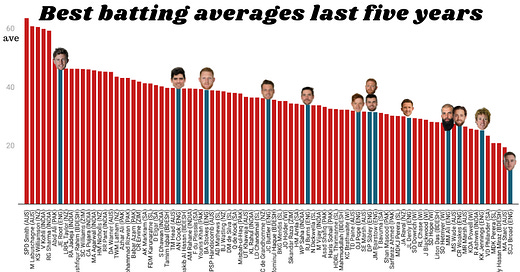


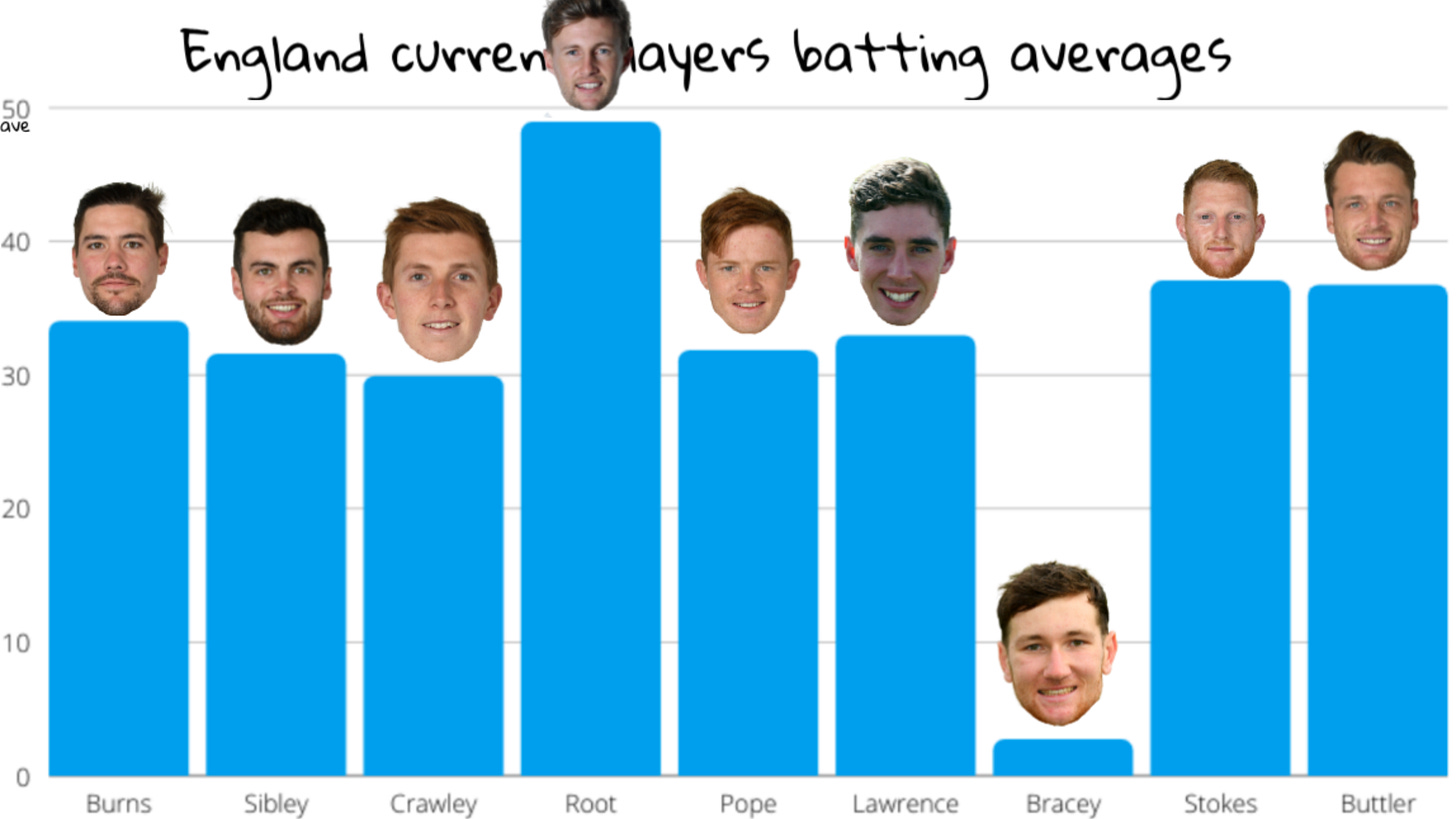
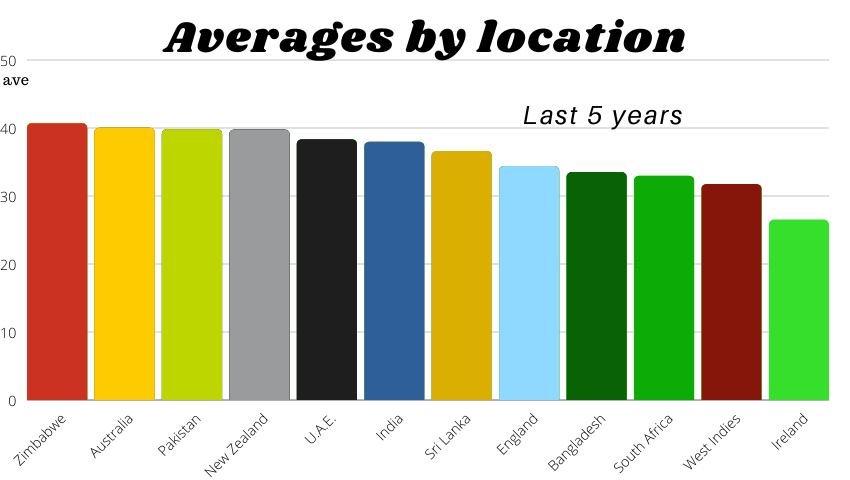
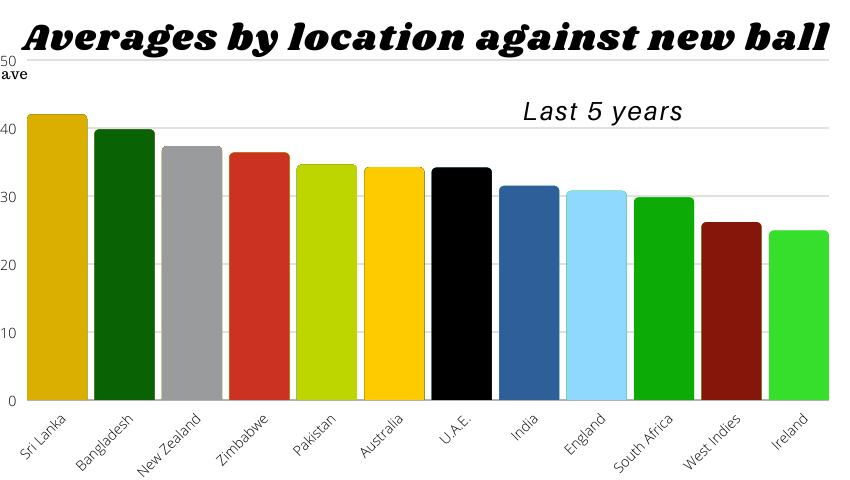
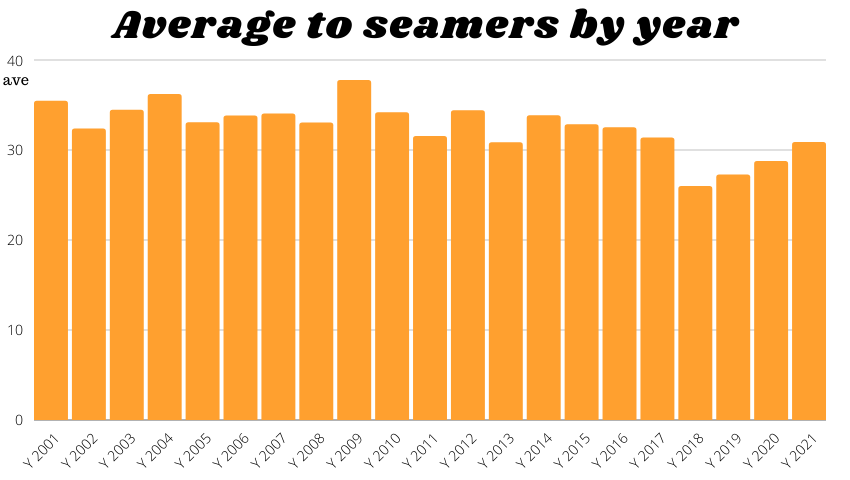
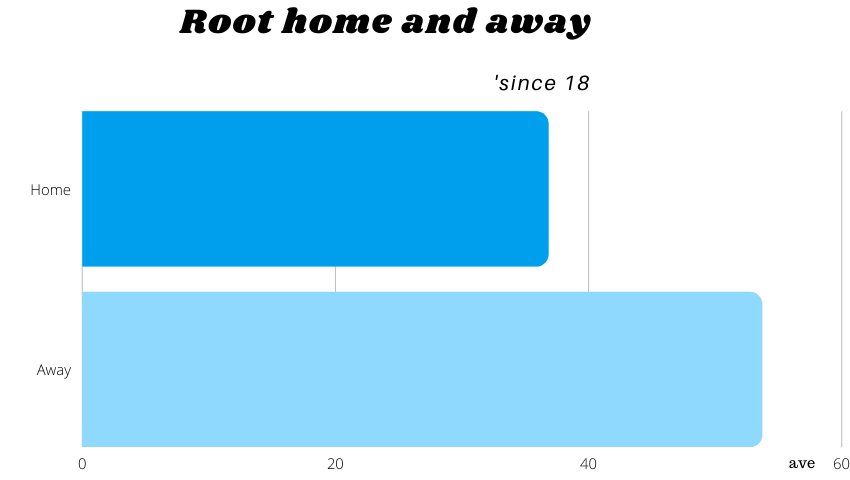
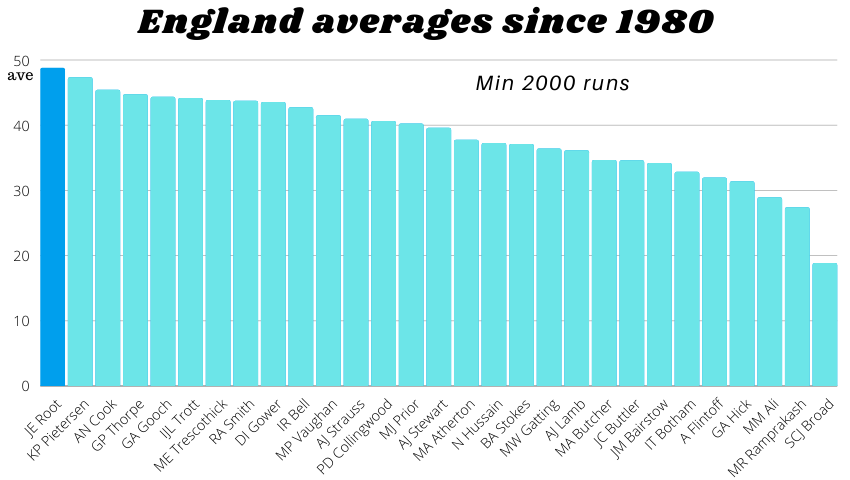
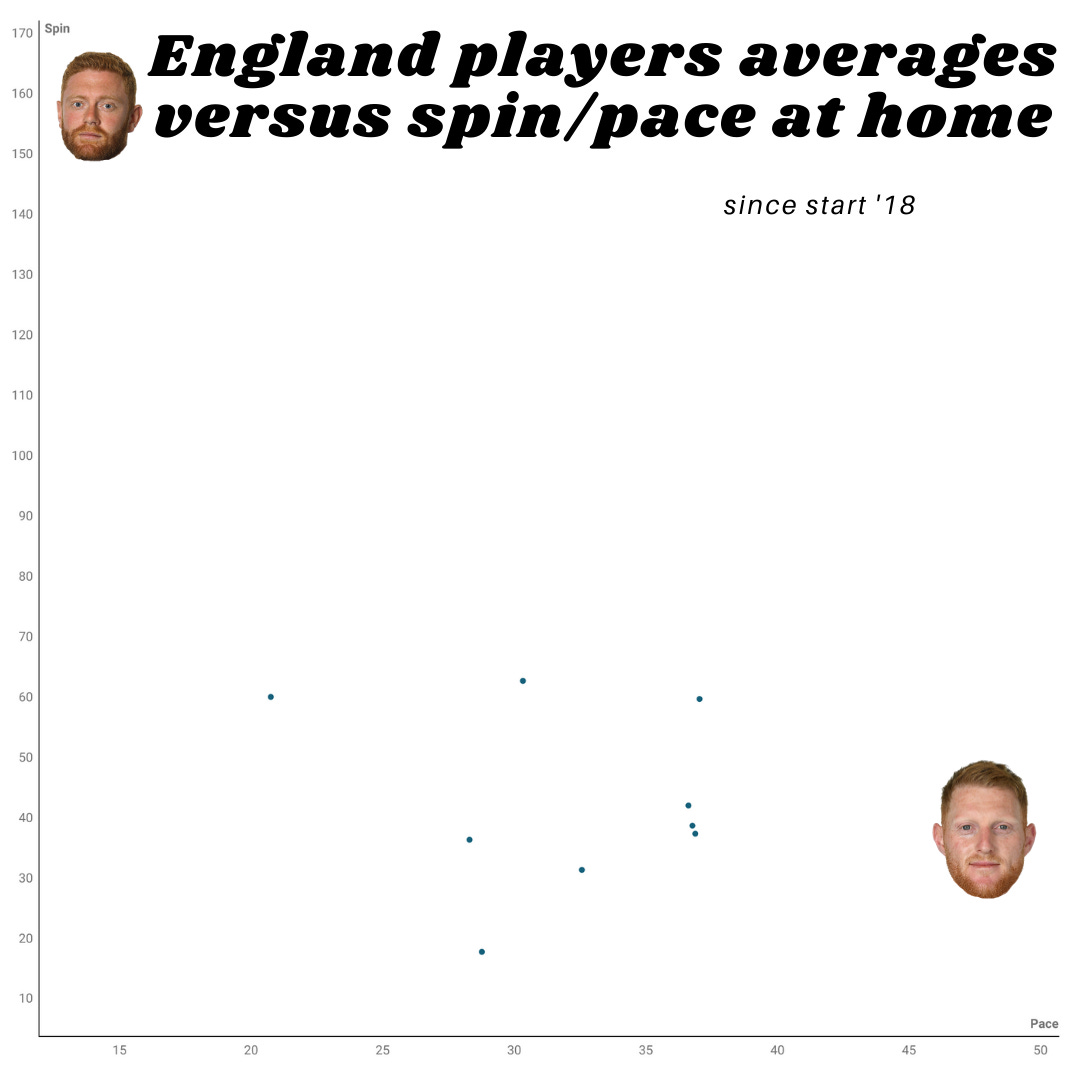
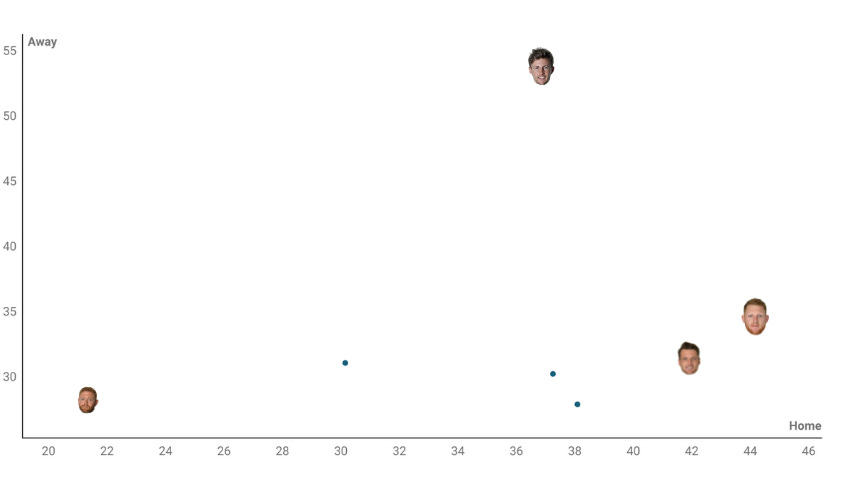
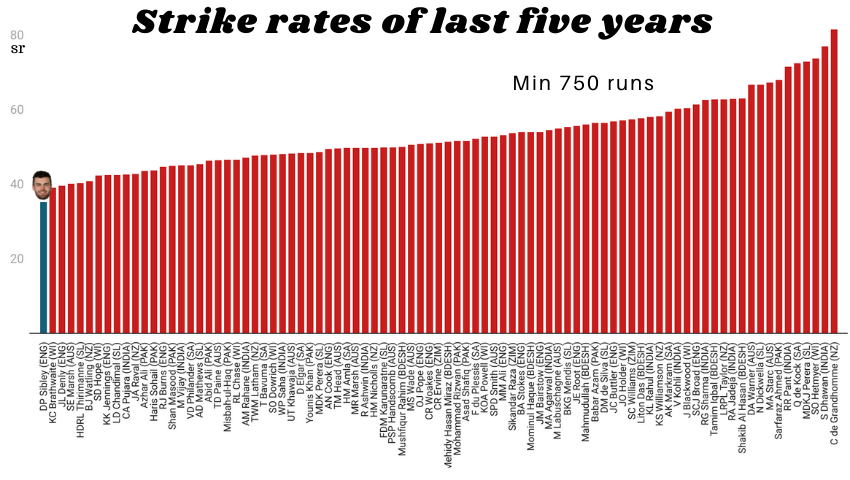
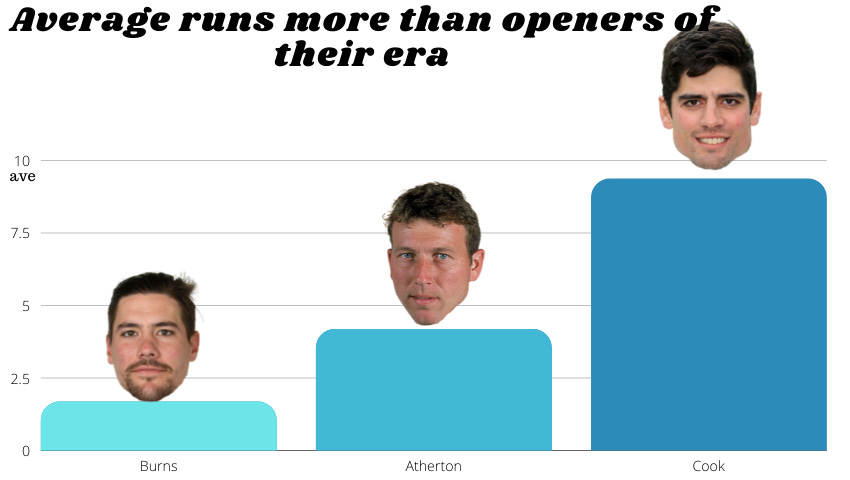


You wrongly assigned black to the UAE rather than New Zealand so I'm afraid I have to reject the rest of your analysis.
But seriously interesting as always.
This is a fascinating article with a lot of nuance. Exactly why I signed up, thanks Jarrod.